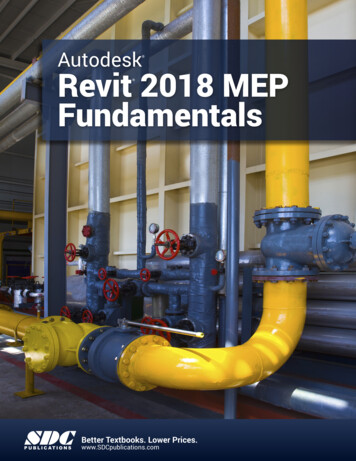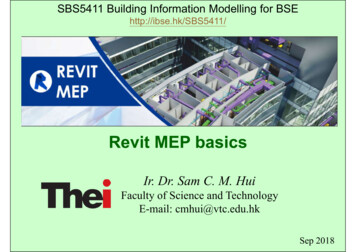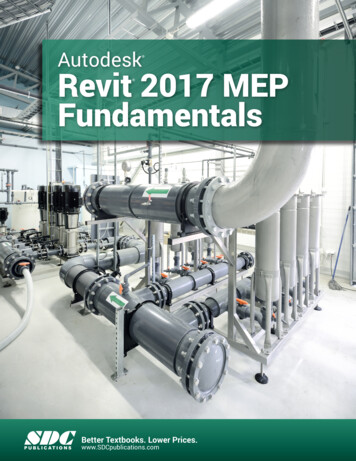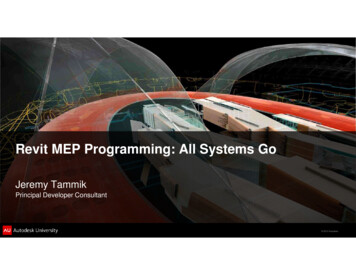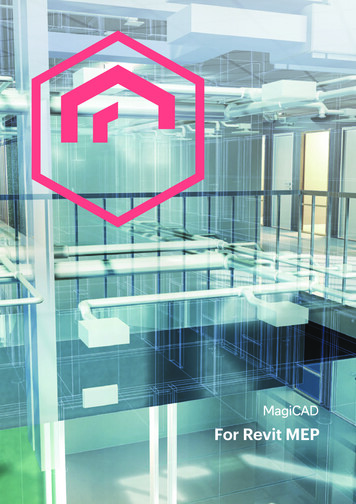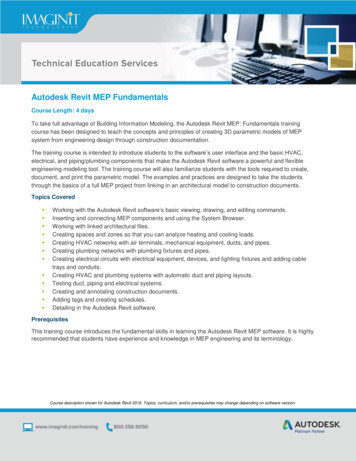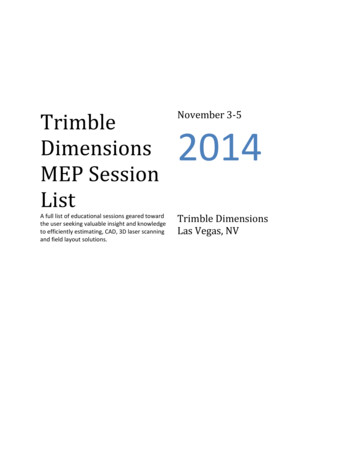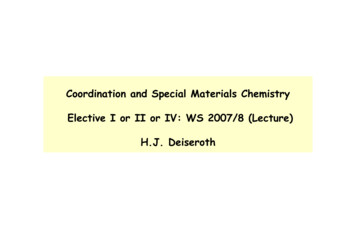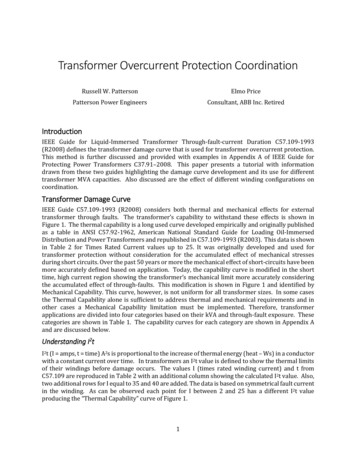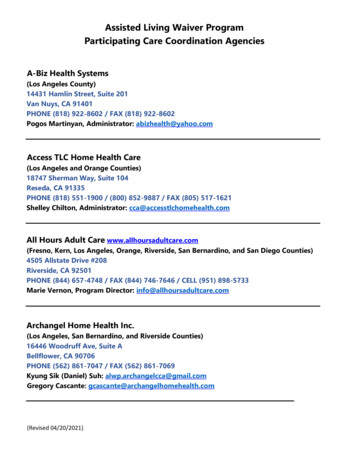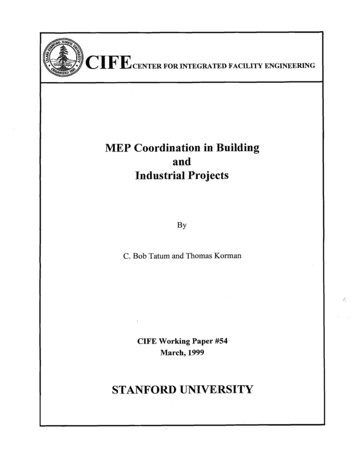
Transcription
CIFECENTER FOR mTEGRATED FACILITY ENGINEEmNGMEP Coordination in BuildingandIndustrial ProjectsC. Bob Tatum and Thomas KormanCIFE Working Paper #54March, 1999STANFORD UNIVERSITY
Copyright O 1999 byCenter for Integrated Facility EngineeringIf you would like to contact the authors please write to:C/OCIFE, Civil and Environmental Engineering Dept.,Stanford University,Terman Engineering CenterMail Code: 4020Stanford, CA 94305-4020
MEP Coordination in Building and Industrial ProjectsClFE Working PaperAbstractCoordination of mechanical and electrical systems to detail their configuration provides a majorchallenge for complex building and industrial projects. Specialized consultants and contractors designand construct these systems. Computer tools can assist with this activity, but fiagmentation ofresponsibility for these systems and the knowledge required for their design make this dficult. Thispaper reports initial results fiom a research project to develop a computer tool to assist in coordinatingMEP systems. It describes current practice, a revised work process using a computer tool, therequired knowledge, development of a prototype system. These results confirm the feasibility ofcapturing specific types of distributed knowledge required and developing a computer tool to assistwith MEP coordination, along with the potential to implement the tool and significantly improve thisimportant project process. Phase two of the project, now underway, will add construction andoperations and maintenance knowledge to the tool and further develop its capability.Page 1
Chapter 1: Research Need, Objectives, and Method1.I Challenge and NeedThis paper describes initial results from a research project at Stanford's Center for Integrated FacilityEngineering. The puipose of this research is to increase the performance of project teams and facilitymanagers in meeting objectives for complex buildings and industrial facilities through improvedintegration and mechanical, electrical, and plumbing (MEP) coordination. The method for this researchfist involves collecting knowledge applied by engineers and detailers during MEP coordination. Thisknowledge is very specialized; therefore, is very dficult for one discipline to know the requirements ofthe other trades. The researchers are representing this knowledge in a computer tool that can identlfyseveral types of problems in MEP coordination and make recommendations for solutions satisfying themultiple types of constraints.MEP coordination presents an unusual challenge for practice and research. Advanced plant designsystems can provide models to assist in coordination, but they are generally not used on hospitals,laboratories, semiconductor wafer fabs, or biotech manufacturing plants. Detailed design andconstruction for these complex facilities are fragmented because specialty design consultants andcontractors perform this work. The root cause of the MEP coordination problem is not the lack oftechnology but the need to apply available technology tailoring to a specific set of business andtechnical conditions. Object-oriented 3D models could allow a revised process of coordination.However, capturing the distributed knowledge concerning the different types of systems and tailoringthe software to meet the special needs of MEP coordination remain major challenges. Success withthis activity would support major improvements in design, coordination, construction, commissioning,operation, maintenance, and retrofit for new uses.The specifications assign responsibility for coordination to the specialty or trade contractors, includingchecking for clearances, field conditions, and architectural conditions. The process of MEPcoordination involves locating components and branches from all systems in compliance with design,construction, and operations criteria. The current process of sequentially comparing 114 inchtfoot scaletransparent drawings for each system over a light table adds significant cost to many projects and canadd significant duration.Improving the coordination process for mechanical, electrical, and plumbing (MEP) systems oncomplex buildings and light industrial projects presents a major opportunity to improve projectperformance through increased integration. Coordination involves defining locations for branchcomponents of systems in congested spaces to avoid interferences and comply with diverse design andoperations criteria.Several problems in current practice create the need to improve. Limited building space for MEPsystems makes efficient design and construction much more dficult. On many plans and specsprojects, accelerated schedules and decreased designers' fees do not allow detailing MEP systems bydesign consultants. The scope of work for specialty contractors on these projects increasingly includes"design assist" to complete the design for fabrication and installation. Design-build contracting, with2/24/99Page 2
different specialty contractors responsible for different systems, decentralizes design responsibility andincreases the potential problems and the need for effective coordination between the different types ofsystems. Fast track projects increase the challenge.MEP systems must satisfy multiple objectives and criteria for design, installation, commissioning,operation, and maintenance. Different types of specialty contractors (e-g., process piping, HVACpiping, W A C ductwork, plumbing, electrical, fire protection, controls) are responsible for thesesystems. Example of diverse criteria for system design include spatial (avoiding interferences),functional within a system (flow or gravity drainage), adjacency or segregation, system installation(layout dimensions, space and access for installation productivity), and testing (ability to isolate). Oncomplex buildings and plants, expertise and designs are required from diverse specialists -- essentialfragmentation requiring horizontal integration between these different knctions working in the sameproject phase.The current work process is for design consultants or design-build contractors to design their systemsindependently. Coordination responsibility is then assigned to one firm, often the general contractor,the HVAC contractor, or a coordination consultant. The resulting process is slow and expensive. Onegeneral contractor estimated coordination costs as six percent of the MEP cost or two percent of thetotal cost on a light industrial project. An electrical contractor said that coordination cost equals designcost on projects in Silicon Valley; each are about three percent of the total cost for electrical systems.At the low-tech end of the practice spectrum for MEP coordination, drawing plan views on transparentmedia and using a light table to overlay routing proposed by several contractors is easy to understandand change. However, this process often involves frequent and difficult meetings. Difticulty invisualizing complex systems in congested spaces often requires drawing multiple section views toaccompany the plans prepared for initial routing. It is also very difficult to accommodate designchange after coordination decisions.At the other end of the spectrum, 3D CAD and other information technology offers the potential toimprove this process and its results. Plant models provide major benefits for large hydrocarbon andpower projects on which the ArchitectEngineer completes the entire design. However, designconsultants and specialty contractors prefer systems tailored to specific information needs for detailing,estimating, fabricating, and tracking their type of woi-k. Current use of multiple systems (e.g.,Intellicad, Quick Pen, Colorado) tailored to the needs of specific disciplines and trades limits overalleffectiveness. The systems are not compatible and DXF transfer usually loses about ten percent of thedatabase contents.Complex configurations of MEP systems in congested spaces are very difticult to visualize. The lesscomplete definition of systems in the "design assist" approach makes it very difticult to define scope ofwork for fixed price contracts. This increases the potential need for contract changes based on theincreased cost of installing the system configuration that results from the coordination process. Also,the first contractor working in an area often optimizes routing for their systems, requiring expensiverework if this is not compatible with other systems.Page 3
As a result of these problems with current processes, the product of MEP coordination does not fullysatisfy the objectives of any of the project participants. To improve project performance, theconstruction segments focused on complex buildings and high tech plants need increased horizontalintegration between design consultants or design-build contractors to improve the effectiveness of thecoordination process and better meet project objectives.This first requires a simplified method to consolidate the designs fiom multiple sources to visualize andeasily change the configuration for initial coordination. The next key need is to capture the knowledgerequired for application of diverse criteria in making coordination decisions. This will eventually allowpartial automation of MEP systems coordination. For improved Mecycle performance of the facility, amajor need is to increase vertical integration by reciprocal information exchange with facility managersand operators for the building or plant. Phase one of this research supports CIFE's integration goals byapplying information technology to improve horizontal integration in the MEP coordination process, amajor need on complex buildings and industrial projects. Phase two is addressing vertical integrationwith construction and facility management, two more major opportunities.1.2 Research purpose and objectivesThe overall purpose of this research is to increase the performance of project teams and facilitymanagers in meeting objectives for complex buildings and industrial facilities through improvedintegration and MEP coordination. The following objectives structure this project:,shorten the duration and lower the cost of designing, coordinating, and installing MEPsystems by reducing the number of meetings required and persons involvedanalyze project needs, information requirements and current process to coordinateMEP systems, along with needed improvementsdevelop and implement a knowledge base concerning design, construction, and thefacility Mecycle for use in analysis and advice during MEP coordinationdevelop and test a tool to coordinate design input fiom each MEP discipline and tradeon a complex building or plant project.1.3 Research method and scopeThis research seeks to capture knowledge of many engineers and detailers who are involved in theMEP coordination process. This knowledge is very specialized; therefore, it is very diEcult for onediscipline to know the requirements of the other trades. MEP coordination is a multi-disciplineactivity, which must consider each discipline and their knowledge of space requirements, installationpractices, and maintenance needs.The method for this research first involved participating in and collecting data regarding currentcoordination activities on complex buildings and industrial projects and analyzing these data to describePage 4
current coordination processes and identlfy potential improvements through the use of informationtechnology for horizontal integration.Baked on this understanding of current practice, we then built a hierarchy of priorities for coordinationto include geometry (physical interferences), functionality (meeting complex design criteria and designintent), construction (sequences, methods, access), and the remainder of the lifecycle (maintenance,repair, retrofit, replacement). The next activity was to represent this knowledge in a tool that, asshown in Figure 1, can make recommendations regarding functionality of the systems, constructionplans and methods, and facility operations and maintenance.Figure 1. Functionality of MEP Coordination ToolKmwledae and Reasonina BaseLife Cycle IssussDesiw IssuesConstrmlion IssuesCorwnentLocationMaterialFuncliirraliiMEP CoordinationToolCoordinated MEP DrawingsAnermtim rouiing optionsPhysicalInlederence Check!Spatial lncwnpatlbilnies Check!Design Intent ChecklM e Cycle Issues ChecklThe tool will allow users to integrate design of systems from multiple MEP specialty contractors into acommon CAD modeL Th.is model of coordinated design will graphically depict the physical layout ofall components and also contain attributes of the objects in the system.1.4 Research activities1. Define the scope and functionality for MEP coordination toolTo d e h e the required functionality of the system, we described improved work process that the MEPcoordination tool will allow. We expect that the tool will include capability for the following types ofanalysis and checking in support of the MEP coordination process:compliance with priorities for system location in MEP coordination, such as whichsystem is routed "high and tight" for first installation and easier supportavoidance of physical interferences between MEP systems and with structural orarchitectural featurescompliance with design requirements for system functionality, such as slope forPage 5
drainage, separation of water and electrical systems, such as less than 360 total degreesof bends in conduit to allow cable pullingreserving "halos" or access paths for construction, operation, or maintenance.2. Collect and represent knowledgePhase one of this research focused on the geometric aspects of MEP coordination. We also beganacquiring knowledge concerning design constraints, construction of the system, and the remainder ofthe facility lifecycle. We continued this activity during phase two to gain the knowledge needed toimplement this functionality related to vertical integration in phase two, focusing on object attributes.Planning for knowledge acquisition included preparing examples of attributes for key objects to use asa basis for feedback by interviewees, and identlfylng projects and experts.We used several techniques and sources to acquire the knowledge needed for the MEP coordinationtooL We completed additional case studies of MEP coordination on projects. We further reviewedengineering literature and vendor data to identlfy and describe design constraints and componentattributes. We also inteniewed engineers, general contractors, specialty contractors, and, operators toobtain knowledge about attributes for specific objects.3. Build the MEP coordination toolBuilding the system involved expanding the object hierarchy and slot tables developed in the PowerModel software for the horizontal integration tool in phase one. We then programed methods andrules to perform the analysis of preliminary designs and provide feedback in the MEP coordinationtooL We also added links to CAD software for input and output, seeking compatibility with AutoCad,Bentley, and software used by specialty contractors, such as Quick Pen for mechanical work.4. Test and validate the MEP integration toolFollowing programming and initial testing to assure that the tool includes the desired functionality, wewill validate the system on a project by comparing the coordinated design obtained by following advicefrom the system with the actual design developed by the project team. The researchers will select arepresentative portion of a project that presents challenges for MEP coordination and develop thedesign following advice from the MEP integration tooL We will then compare the detailedconiiguration with that actually developed for the project, identify the differences, and discuss themwith the project team. If these differences indicate a need to acquire and represent additionalknowledge in the tool, we will complete this and further validate the system. Based on the results ofinitial testing and input from the IAG, we will identify additionalknowledge, further programming, andfurther testing needed to complete the MEP coordination tooL We will then take these actions tocomplete the agreed scope and capabilities of the tool for phase two.5. Hold meetings of industry advisory group (IAG)Phase one of this pro-ject benefited greatly from a committed and active IAG. Each of the types offmns involved in MEP coordination is well represented. At IAG meetings during Phase 2, we2/24/99Page 6
described the MEP coordination tool, give the results of testing and validation, and summarize ourcurrent plans for refinement. We will obtain comments from the IAG regarding each of these topicsand suggestions for actions to r e h e and further test the tooL The final meeting of our IAG will focuson overall results of the project, including comments on results of testing and validation, conclusions,recommendations, and plans for future research. We also expect our IAG to assess the potential for asponsored project to further develop the integration tool and, hopefully, form the core group to make ithappen.6. prepare CIFE report, journal papers, addition to web pageWe will summarize the results of developing and testing the MEP coordination tool and conclusionsconcerning increased understanding of MEP coordination and recommendations for practice. We willalso highlight interesting research issues for future MEP projects and actions to supportcommercialization of the tooL We will disseminate results of this research by a CIFE report, journalpapers, and a web page. The CIFE report will describe the research activities and results and will adescription the MEP coordination tooL We anticipate two technical papers, one with a research focusand one for practice. We will also post the results of phase one and plans for phase two on the webpage created for this project.1.5 Readers' guide for this reportChapter two of this paper describes the current process for MEP coordination, including differences onprojects using different delivery approaches. Chapters three and four define the capabilities andknowledge required for the MEP coordination tool and the revised work process to use it. Chapterfive describes our process to develop and test the tooL Chapter six highlights our preliminaryconclusions and recommendations regarding the use of a tool to improve MEP coordination.Page 7
Chapter 2: Current practice for MEP CoordinationUnderstanding current practice for MEP coordination is essential to recognize the opportunity toimprove and to develop effective computer tools that support improved processes. Recognizingfundamental constraints from industry organization is essential to develop a tool with potential forimplementation. The following description is based on interviews with engineers, general contractors,and specialty contractors who have extensive experience with MEP coordination. It also includesinformation gained during observation of several MEP coordination meetings. This section ends with asummary of the limited published background concerning MEP coordination and related research.2.1 Overview of Current PracticeComplex buildings and light industrial projects, using either the design-bid-build approach, the designassist approach or the design-build approach, require coordination for MEP systems. The engineerfirst prepares mechanical, plumbing and electrical specifications, assigning full responsibility forcoordination to the specialty contractors, including checking for clearances, field conditions, andarchitectural conditions. On design-bid-build projects, the engineer also prepares diagrammaticdrawings of MEP systems to establish the scope, materials, and quality, but not detailed layout orinstallation instructions. The specification requirements and drawings provide the information inputsfor MEP coordination.After contract award, the process for MEP coordination begins with the specialty contractors(primarily HVAC wet and dry, plumbing, electrical, and fire protection) preparing sho
Center for Integrated Facility Engineering If you would like to contact the authors please write to: . integration and mechanical, electrical, and plumbing (MEP) coordination. The method for this research . several types of problems in MEP coordination and make recommendations for solutions satisfying the
